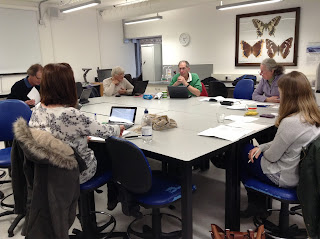 |
| Getting started with the Rose Family: a page from Faith's Pocket Guide to Wildflower Families |
Over those years, a guide to common plant families has been tested and refined and I hear that the students have all voted it very helpful for identification.
 |
| Learning about plant structure with Faith's hand-outs |
The weekend workshops are run by Dr Faith Anstey and her team of BSBI tutors, and will be held this year at four locations across Scotland.
Click on the link to book your place on any of the workshops:
The aims of these weekend workshops are to teach you how to identify wild flowers through recognising their families and to help you build up your confidence in using identification keys.
 |
| Tutors and students work together in small groups |
Then Faith introduces you to plant families, with her specially designed booklet containing a flowchart to, and descriptions of, 24 common families to enable you to ‘find the family first’. This makes it much quicker and simpler to identify the species at hand.
At this point, you split into groups and the tutors guide you through using the flowchart to work out the family.
After lunch, Faith introduces you to using ID keys - always a hurdle to get over when starting out but again you have a chance to work in small groups with Faith and the other tutors, both in the classroom and in the field.
Fieldguides and handlenses - the essential tools of the botanist's trade - are essential equipment here, but you don't need to worry about buying these items in advance if you don't already have them: Faith and her team will have spares for you to try out, as well as lots of handy hints on how to use them.
On the Sunday morning, there is a follow-up field excursion where you spend three hours practising your new-found field ID skills and again there is lots of support on offer whenever you get stuck.
I asked Faith to tell us what sort of people attend the Saturday workshops and what she feels they get out of the workshops, which are proving so popular! Here's what she said:
 |
| Getting started with the Campion Family |
"The basics of plant structure and
nomenclature are reviewed. Then a flowchart is introduced which covers 50
families and has a high record of success in leading students to the correct
family for a given specimen.
"This is supported with descriptions of the typical
characteristics of 24 families.
 |
| Workshop participants practice their skills at the follow-up field meeting |
"The course has proved so popular that the Pocket
Guide to Wildflower Families, an A6 spiral-bound weatherproof booklet
containing most of the material, is now on general sale, at http://www.wildflowerstudy.co.uk".
Many thanks to Faith for telling us more about the Plant Families Workshops. They book up quickly, so if you are interested, please use the links above to reserve your space, or go to the BSBI Scotland pages here.
All images courtesy of Faith Anstey.
All images courtesy of Faith Anstey.
















